Keith Armishaw writes: 'I've fished since I was a boy, and have learned so much over the years by reading the books of great angling writers, such as Fred J. Taylor, MBE., Fred Buller, Richard Walker et al, but one thing's for sure, you never stop learning.
I had a desire to broaden my angling experiences by fishing overseas, and who better to ask for recommendations, than our good friend, Fred J., (as he was affectionately known) who sadly died on the 7th May, 2008, aged 89. He suggested that we should start with Canada, which has so much to offer.
There were two potential destinations; one was fishing for lake trout in the Arctic Circle. This involved trolling for hard-fighting fish, which didn't really appeal to me because, if I did manage to catch anything, it was more likely to be as a result of the skipper's skill, rather than mine! Also, I had to consider my significant other, Sandy, and daughter, Jenny, who would be travelling with me, and although the accommodation at that destination was described as five-star, I opted for the second suggestion, which had much greater appeal.
Fred J. often told us of the times he spent fishing in Manitoba with Stu McKay, a Red River guide, and close friend, and of their winter camps on the Winnipeg River system. Fred described the Red River as a 'fish factory,' and said that I would love it, although the basic accommodation was more for anglers than for luxury holidays. Of the two destinations, I chose fishing with Stu McKay, who owns Cats on the Red at Lockport, just outside Winnipeg, and his business is situated right on the banks of the Red River, which was just a few paces from our front door. Ideal!
Stu told me not to worry about tackle, he'd supply everything. Fred and Stu told me that the river was full of carp in the earlier part of the season, and that catfish would also be found there. American anglers arrive at the end of September-early October, to fish for Walleye (the American Zander), so I decided that we'd travel in early September, even though there wouldn't be a proliferation of any particular species, it would give me chance to try for different fish, using different methods. Speaking personally, that's the joy of fishing, and I'm always happy to learn from someone with more experience, and hopefully, catch some good fish in the process.
Sandy, Jenny, and I arrived at Winnipeg airport on the 10th September, 2007, and were greeted by the legendary, Stu McKay, who told us that we needed to hire a car. It's a necessity when travelling around such vast countryside. That was our first (expensive) mistake. We found that it would've been cheaper to pre-book. We also took out insurance with an excess of two hundred & fifty pounds. No problem, we said - Hmmm! - famous last words! We did have a problem, when some bored kids tried to steal the car, and damaged it in the process. It was a very costly mistake on our part so next time, we'll pre-book and pay a little bit more for total cover, with no excess. Also, I'd consider booking a direct flight from the UK. I'm not recommending any particular carrier, but Zoom operate a direct flight to Winnipeg. (Since writing this article, ZOOM has suspended operations - such a pity - hope they get going again.) Not only is this shorter, and considerably cheaper than the one we used, it's less taxing on the nerves, as you don't go via Chicago. Also, our outgoing flight was late, so we missed our connection. Then we had to hang around the airport for hours waiting for the next flight, and all I wanted to do was get to Lockport and FISH!
Anyhow, we eventually emerged from the airport into a chilly, wet, grey evening. Undaunted by the cold drizzle, we hopped into our hire-car and followed Stu to our final destination at Lockport, which is only a short, easy drive (especially when you're being chauffeured by your very obliging daughter!). Cabin number one (Fred's old cabin) was slap-bang next to the Red River - I couldn't have been happier. One of the reasons why the fishing there is exceptional is that it's home to one of the largest curtain dams in the world, and the fish just like to hold-up close by, where they find all of the food they need to grow to a good size.
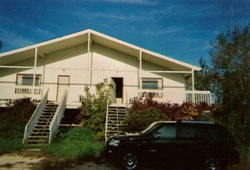
And Fred was absolutely right when the said that the accommodation was more for those who just want to fish, but it was comfortable enough, with shower, toilet, two twin-bedded rooms, and a living space which housed a fridge, (for bait and cold beer!) percolator, microwave, and a small television (unused when the fish were biting, which was most of the time!). All great for the non-cook, but Sandy was having withdrawal symptoms because she wanted to cook local food. Not to be deprived of one of her favourite pastimes, she and Jenny drove off to down-town Selkirk, where they found a four-pan sandwich toaster, which they bought from a from a thrift shop for 1$! And with a little ingenuity, managed to cook scallops and prawns in garlic butter, amongst other tasty morsels! Not as lavish as Fred's splendid banquets he used to produce in winter camp, but great when you've been fishing all day and have a keen appetite! It wasn't until the end of the stay that she discovered she could have used Stu's barbecue facilities, which are situated behind his outfitters' store. (In Canada, an outfitter supplies tackle, bait, and permits, rather than gentlemans attire!)
Selkirk, mentioned earlier, is the nearest sizeable town, and is just a short ten-minute drive away. Here, you'lll find everything you need for your stay, including a variety of fast-food outlets, and one of the best supermarkets Sandy & Jenny have ever seen, with great service, and fresh produce for the keen cook! We were also struck by the friendliness of the local people, and were made to feel very welcome. It's not hard to see why Manitoba is known as 'the friendly State.'
Lockport, where Stu's business, Cats on the Red, is based, is a small town, built around a huge dam, which is also the crossing point over the Red River. It has an undeserved industrial feel about it, but it's only a short distance from the Canadian plains, which roll out before you on seemingly-endless, straight, wide roads, which make travelling around in a 4x4 more like cruising in an armchair! An unexpected pleasure if you find driving a pain.
I was up early on the 11th September, keen to talk to Stu, and get his good advice on where to fish, and how. He told me to start fishing just above the dam, where a small submerged drain runs into the river. He'd shown me this area the previous evening, whilst we watched a huge flock of Brewer's Blackbirds take off and land on a nearby mere.
Stu loaned me an 11' carbon rod he'd picked up in the UK, and I used the centre-pin reel I'd taken with me (which I prefer to fish with). The weather was breezy, and overcast, and after a short while, I connected with my first fish, a common carp. It tore about like wildie, and was a well proportioned fish of about 6lbs.
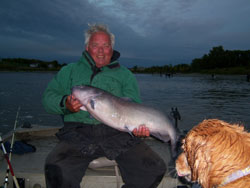
Then Stu turned up and asked if I'd like to join an American who'd just arrived with his own boat. This was great - never having experienced boat fishing to any degree, it sounded like a good idea (and it was!). I was introduced to Dave Shefland, from Minnesota, who had enough tackle for both of us; we jumped into the boat, along with his fishing buddy, Ben the dog! I should point out that The Red is not like the rivers over here, as it runs into Lake Winnipeg, a truly massive freshwater lake that appears large enough to swallow Wales (UK)! The size makes The Red tidal. It's a major river by UK standards, and a northerly breeze on Lake Winnipeg causes the river to rise and fall by over a metre.
Dave, Ben and I cruised down The Red for about a mile, quickly leaving all signs of civilisation behind us, and we started fishing for channel catfish, in an area that Stu had recommended. We used solid glass boat rods (can you believe they cost just $10 each in the US!?) with multipliers, 25lbs. line with 2ozs. of lead to hold bottom, and a piece of fish (tulibee) for bait. The American way of doing this is to put the rod in a holder, and wait for the line to run before striking into the fish. We tried for a couple of hours, and after having a few taps, which I was told were probably small fish, Dave had his first catfish. These are 3-5lbs. in the States, but this one was double figures. Dave said that this stretch is known as the golden mile when fishing for the cats, and I was happy to see such a large specimen. Little did I know, but this was the smallest catfish that we would catch that week!
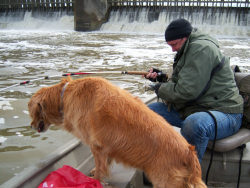
Dave rebaited and after a few minutes, he was into a much larger fish, which was just under his personal best for that stretch. It weighed 24 lbs. After all that activity, the swim went very quiet, so we moved upstream to the dam area, and fished a few yards below the dam face, in the fast flow. We set up as before, and I was still getting nuisance taps. Dave had another cat of just about 20lbs., when I decided to strike at a tap. I was surprised to connect with a cat, and over the next three hours, I caught three more, all around 20lbs. and had the hook pull out of another three fish. Dave joked that he'd never seen a hook pull out of a cat before, and if I did it again, he'd throw me overboard! I told him there was no need; I was so frustrated, I'd jump.
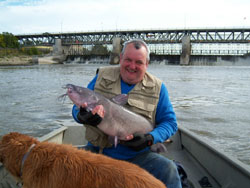
We ended the day at dusk having four fish apiece, and I really enjoyed experiencing new methods of fishing. The day gradually brightened, but the temperature dropped rapidly as we moored the boat just below the cabin. After a quick scrub-up and change of clothes, we all headed down to Selkirk for a glug and something hot to eat.
Red River cats are hard fighters, even on heavy boat tackle. You could get them to the boat, but it was real struggle to get them into the net and up onto the boat I really knew I'd been fishing by the end of that day!
One point to note here is that Canadians, who generally fish to eat, only allow one rod per angler, and I wholeheartedly agree with this policy, not only because two rods would be too cumbersome and reduce the level of activity; and barbless hooks are mandatory. Finally, if an angler does take a fish, it has to be BELOW a set limit. This not only preserves fish stocks, but it also allows you to eat the optimum-sized fish for flavour. We, in the UK could learn from this approach.
One of the extraordinary sights at Lockport, was the number of Vietnamese immigrants, who live in the surrounding areas, and who regularly fish immediately below the walls of the dam. Many were spinning, and it was astonishing to see them jostling each other for space, (at times they were barely six inches apart!) and then squabbling amongst themselves when they got tangled up in each others lines! A practice not recommended for a peaceful pastime, but understandable I guess when youre catching fish for the table.
It was a similar sight on the river, when, if you were catching fish and no-one else was, people would be drawn to your spot, and those fishing from boats would edge nearer, whilst keeping a respectful distance. This all sounds like there is huge pressure on the fishing in this area, and at weekends, that's half-true, but the Red River is vast, fish are plentiful, and you only have to move a short distance to feel that you're far from civilisation.
The next day, Dave and I took the boat straight up to the dam again, and had sport throughout the day, only breaking at lunchtime for Dave to cook his bluegills that he'd brought with him in a coolbox, from Minnesota. Stu fried chips, and we had an open air feast, the aroma from which drew in the local ranger! (The relaxed friendliness and generosity of the people that we met, made our first overseas fishing trip a real joy).
By the end of the day, Dave and I had eight cats apiece, my best was 24.5lbs. Dave was trying to beat his best, and as we were about to pack up, he had a really good one, but how unlucky was this? His electronic digital scales had misted - the temperature had dropped, and the light failed, and as the display was liquid crystal rather than light emitting, we couldn't read it! We both believed it was well over 25lbs., but couldn't prove it. I also discovered that when you get a knock, you can tease the cat into taking, by slowly drawing the bait, until you can feel the weight increase, then striking. I didnt lose a fish that day, and managed to catch, even though the bites were mostly just the taps I'd ignored on our first day.
All the cats that we caught were about the 20lbs mark, which, for an average size, is phenomenal, and most would have been recognised as trophy fish, under the Manitoba Master Anglers' programme. (You should note here that Fred J. was the first non-North American to gain the title of Grand Master, receiving a gold medal for catching 10 different trophy species.) This programme rates the fish on length, rather than weight. Dave had to return to Minnesota the next morning, so to thank him for his splendid hospitality and companionship, we all went off the Selkirk for dinner. He still keeps in touch by email, and sends me some great photos of his latest catches, as you'll see in this diary.
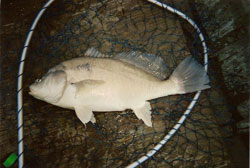
The following day, Stu said I could help myself to one of his boats, and gave me some heavier tackle and bait. Again, I went up to the dam, but the sport was noticeably slower following the previous cold night, when the temperature dipped below zero. However, the following day, it reached a peak of over 25 C. These fluctuations seemed to adversely affect the fishing, but I persevered and when I hadn't caught a cat, quickly switched to the light rod and centre pin, using a worm for bait. Immediately, I was into another species of fish, which fought well in the rapid current. It was a drum, which looked a bit like a hump-backed sea bream, but this was a specimen fish of about 10lbs. which again, would probably have qualified as a trophy fish. Then I didn't have a bite for an hour or so, and switched back to the heavier tackle, using dead fish strips for bait which yielded a smaller drum.
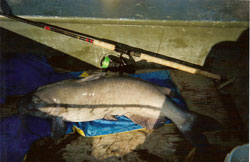
When fishing, I like to explore fresh swims, and began moving the boat into shallower water where at last, I located the cats. I had another five before the day's sport ended, and although I couldn't weigh the fish without scales, estimated the best to be around 27-28lbs. It looked a real bruiser in the bottom of the boat!
But I don't just fish to catch; I love to watch the wildlife, and there was plenty to see in Lockport and the surrounding areas. From the boat, you could watch the birdlife, which included the great blue heron; double-crested cormorant; cliff swallows; spotted sandpipers; the belted kingfisher, American white pelicans, herring gulls, and my personal favourite, the black-crowned night heron. A real treat for any ornithologist, and Sandy sighted a spectacular monarch butterfly .
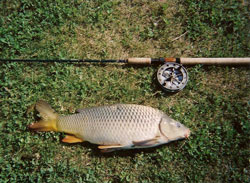
The next day, I thought I'd try another technique in a different location. Stu suggested that I cross the dam, and go a few yards upstream to where a creek flows in, and he suggested that I fish the river at the mouth of this creek. He also said that I'd catch there; so off I went, carrying a light rod, centre pin reel, and small lead with lobworm (known locally as night crawlers) for bait. Sport was slow, but I caught a hard-fighting carp of about 9lbs., and then a
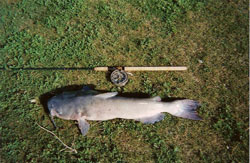
catfish.
This gave a dour battle on the pin and 8lbs. line, before being netted. It was interesting that, although this cat was nearly as long as those caught below the dam, it was only half the weight. Perhaps the Manitoba system would be better to use fish weight rather than length.
Anyhow, I had a break in the afternoon, and returned to the cabin. I asked Stu what else I could fish for. He suggested that I try jig-fishing for sauger and walleye. These two species are very similar in small size, but the walleye grow bigger, and can be identified by the white patch on the lower lobe of the tail. Saugers are like our 'suicide' perch; they swallow everything, and only reach about 2lbs. in weight.
After jigging from the jetty, a couple of local lads pulled their flashy boat alongside, and asked what I was after. I told them, and that I was inexperienced in jigging, so I asked for their advice. They suggested a pickerel rig might be better, and that I should throw it out to the middle of the river. A pickerel rig is basically a lead, tied onto the bottom of a line with two droppers. On this is mounted a dead minnow, or a worm, and I was advised to strike when I felt a tug. They invited me to join them in their boat to fish further along the river for walleye, so I jumped at the chance and off we went. (Would you be asked, or even do this in the UK? I don't think so somehow). This trip lasted for around an hour, but the only fish we had was a small white bass, which that I caught on a jig.
The next day was spent (in protest) with Sandy and Jenny, apart from a couple of hours at dusk, when I decided to try out the pickerel rig, but I couldn't get the range with the pin, or the heavier tackle, so struggled to catch one sauger. I might add here that the locals used the same method at over 80 yards, and caught quite a few fish!
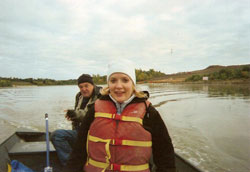
A new day dawned, and I was up bright and early, amidst cries of 'Shut up!' and, 'Be quiet, Im sleeping!' I couldn't wait to fish, so at the first opportunity, I jumped into one of Stu's boats, and set off down the river in search of walleye. After an hour or so, I'd only caught a sauger, so went back to collect Sandy, and Jenny, who wanted an outing in the boat to look at the pelicans on the far shore. We'd never seen them in the wild before, and were keen to get a close-up view, but near-disaster struck as we ran aground. But it was ok, my landing net made a great pole! Having re-floated the boat, and motored further down the river, I handed my rod
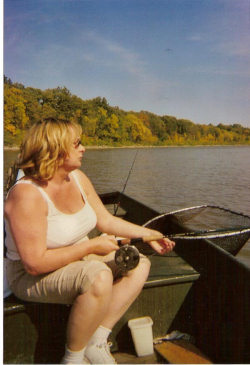
to Sandy who, true to form, immediately caught a sauger! Ive said it before, but I mean it this time (maybe!), I'm definitely not taking her fishing again!!!
Later, I drifted a few yards downstream to where the spillway, which protects Winnipeg from flooding, rejoins the Red. I tried with a jig, but wasn't convinced that this looks natural to the fish, even when baited with a dead minnow. I then decided to change the set-up. Having still got the pickerel rig, I attached the lead to a swivel and fed the line through to a dead minnow, mounted on a single hook, on a simple paternoster rig. I thought that this would be more natural, with the minnow appearing to swim in the current. Having changed this rig, the catch rate improved dramatically. In the next two hours, I caught six sauger, two walleye to about one and a half pounds, a goldeneye, and three stone cats which only grow to about 8 inches. This shows that trying different methods and by combining UK and local experiences can yield fish. Although they were only small, I enjoyed this experience as much as catching the big cats, and probably learnt a lot more.
The other thing that I learned is, everything in that river has teeth! I feel sorry for the poor bait fish such as minnows; they don't stand much chance of survival, when even the goldeneye (which is a bit like a roach) has teeth.
This really struck home when one of the sauger took the minnow right down in true small-perch manner. After retrieving the hook, the fish was a bit slow recovering, and before it had gone four feet past the end of the boat, a herring gull dropped down, and started to eat it and it didn't end there. Before it had got very far with its meal, a pelican landed right next to the gull and harassed it into surrender. The cards were certainly stacked against that little sauger!
The following day, I took a long-awaited trip with Stu and Pete Mackenzie to fish for lake sturgeon in the Winnipeg River system. This is more like a network of lakes, with hydro-electric stations between them, which provide the power for the area. This expedition was fully guided by Stu, who took along his boat, 'Catillac,' a very comfortable large craft, which he towed on a trailer behind his pick-up truck. But the journey was a near disaster!
As we drove to our destination, we were stopped by an over-zealous traffic cop, who noticed that the tail lights had failed on the trailer. He then said the paperwork wasn't right for the weight of the vehicle, the braking system was inadequate, and that we had to take the vehicle off the road. After about two hours, an electrician turned up and fixed the lights, but it turned out that the braking system WAS ok! The cop just didn't know how it worked, and the paperwork was a clerical error in the system. All in all, we unnecessarily lost about three hours' fishing time!!! It seems that bureaucracy can strike in Canada too!
This experience was then compounded when we got a call to say that our hire car had been broken into by kids looking to joyride. They didn't manage to start it because of the security system, but it cost us the excess on the insurance policy, on top of the hire cost, in all around 950 for ten days. (Ouch!!) The kids damaged 18 cars before they found one that they could drive away. I must say though, we were pretty impressed with Hertz, whose main office is in Oklahoma. We had a brand-new top of the range, 4x4 delivered within two hours. (Here, we have to thank Callie, Stu's daughter, who took care of all contact with the Mounties and the car hire firm, so no worries there apart from the car-hire bill!).
Anyhow, back to the fishing! On the way, we passed a small beaver-dam, and as we reached the river system, noticed a loon fishing, and we stopped to watch it for a while. We also saw killdeer, bufflehead, wood duck, and the more commonly-sighted Canada geese. Fishing, for me, is about being part of nature, and not just catching fish, and one of my greatest pleasures comes from watching the wildlife.
Eventually, we launched the boat into the water, and anchored, with some difficulty, in the fast water below the hydro-electric station. We fished with a boat rod, 24lbs. line on a multiplier with a hook baited with a worm/dead minnow cocktail. The flow was so strong, it took 6ozs. lead to hold bottom. The day was cold, overcast and breezy, pretty bleak really, and we struggled to get a bite. However, our mood lifted as we watched a pair of bald eagles, and a turkey vulture, circling overhead. These are truly spectacular birds and a great diversion from our failure to catch.
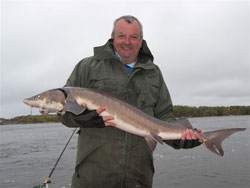
Then finally, I had a bite, and after a short battle, boated a 47.5 lake sturgeon, a smaller species than the one caught from the Fraser river. And as you can see, this one was a trophy fish, again being over the 44 qualifying length. The light faded all too soon, so it was time to put the boat back on the trailer, and head back. The delay with the cop had meant that we couldn't go on to see where Stu and Fred J. used to set up their winter camp at Jackfish Bay, or try to catch pike and perch. And Stu told me that there's a three-lake beaver dam there, which is the biggest he's ever seen. Thats something to look forward to seeing the next time we visit.
Sadly, that was the end of my fishing trip, but what an end. Sandy says one photo of me with the sturgeon looks as though I'm snogging it - I'm not of course, but what a catch! On the last day, we drove to one of the wildlife parks at Birdhill. The countryside there is wonderful, with vast areas covered with trees whose foliage was turning to burnished gold amongst the green; there were lakes, and plenty of butterflies and wildlife active in the late afternoon sun. We saw wild turkeys, and deer. And Jenny had a chance to go horse riding American style which was a great, if unnerving experience, as she galloped through woodland with a cowboy, who thought he was The Lone Ranger!.
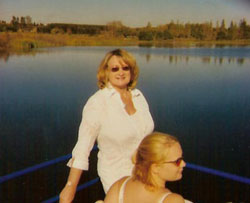
As Sandy and I walked around the edge of the lake, we saw black-billed magpies, sedge wrens, western grebes, American crows, buffleheads, house sparrows and starlings (the latter two are imports from the UK, which gives the Canadians the same problem as we have with American crayfish). This was a great family day out, and a fitting end to a memorable trip.
Having recently read one of John Wilson's books, he says that if he was younger, he would consider emigrating to Canada. Having returned home, Sandy and I both agree with him. We will go back and explore other areas, and we have to visit Jackfish Bay to fish for the pike and perch Fred J. used to catch and cook on an open fire at winter camp. And we really must take that walk with Stu, to see that massive beaver dam he described to us with such eloquence, in his wonderful Canadian drawl.

It's true to say that a good experience can leave you wanting more. This one certainly did, and we were able to pass on our thanks to Fred J. for his first-class recommendation.
And last, but certainly not least, we thank Stu Mackay. He was the perfect guide, who shared his good advice, and then left me to get on with the pleasure of fishing and catching, - the very best way to learn new methods, and the one which I enjoy most of all. His knowledge and skill guided me to the sturgeon in the fast flows, and ensured that I caught the fish I'd dreamed of - what more can anyone ask?
(River Reads' Fishing Diary was written by Keith Armishaw, and edited by Sandy Armishaw). (February, 2008)